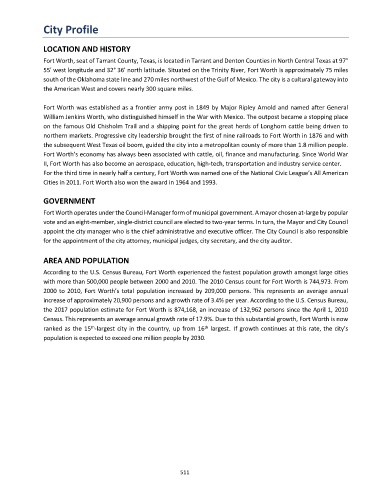Page 550 - Fort Worth City Budget 2019
P. 550
City Profile
LOCATION AND HISTORY
Fort Worth, seat of Tarrant County, Texas, is located in Tarrant and Denton Counties in North Central Texas at 97°
55' west longitude and 32° 36' north latitude. Situated on the Trinity River, Fort Worth is approximately 75 miles
south of the Oklahoma state line and 270 miles northwest of the Gulf of Mexico. The city is a cultural gateway into
the American West and covers nearly 300 square miles.
Fort Worth was established as a frontier army post in 1849 by Major Ripley Arnold and named after General
William Jenkins Worth, who distinguished himself in the War with Mexico. The outpost became a stopping place
on the famous Old Chisholm Trail and a shipping point for the great herds of Longhorn cattle being driven to
northern markets. Progressive city leadership brought the first of nine railroads to Fort Worth in 1876 and with
the subsequent West Texas oil boom, guided the city into a metropolitan county of more than 1.8 million people.
Fort Worth’s economy has always been associated with cattle, oil, finance and manufacturing. Since World War
II, Fort Worth has also become an aerospace, education, high-tech, transportation and industry service center.
For the third time in nearly half a century, Fort Worth was named one of the National Civic League’s All American
Cities in 2011. Fort Worth also won the award in 1964 and 1993.
GOVERNMENT
Fort Worth operates under the Council-Manager form of municipal government. A mayor chosen at-large by popular
vote and an eight-member, single-district council are elected to two-year terms. In turn, the Mayor and City Council
appoint the city manager who is the chief administrative and executive officer. The City Council is also responsible
for the appointment of the city attorney, municipal judges, city secretary, and the city auditor.
AREA AND POPULATION
According to the U.S. Census Bureau, Fort Worth experienced the fastest population growth amongst large cities
with more than 500,000 people between 2000 and 2010. The 2010 Census count for Fort Worth is 744,973. From
2000 to 2010, Fort Worth’s total population increased by 209,000 persons. This represents an average annual
increase of approximately 20,900 persons and a growth rate of 3.4% per year. According to the U.S. Census Bureau,
the 2017 population estimate for Fort Worth is 874,168, an increase of 132,962 persons since the April 1, 2010
Census. This represents an average annual growth rate of 17.9%. Due to this substantial growth, Fort Worth is now
ranked as the 15 -largest city in the country, up from 16 largest. If growth continues at this rate, the city’s
th
th
population is expected to exceed one million people by 2030.
511

